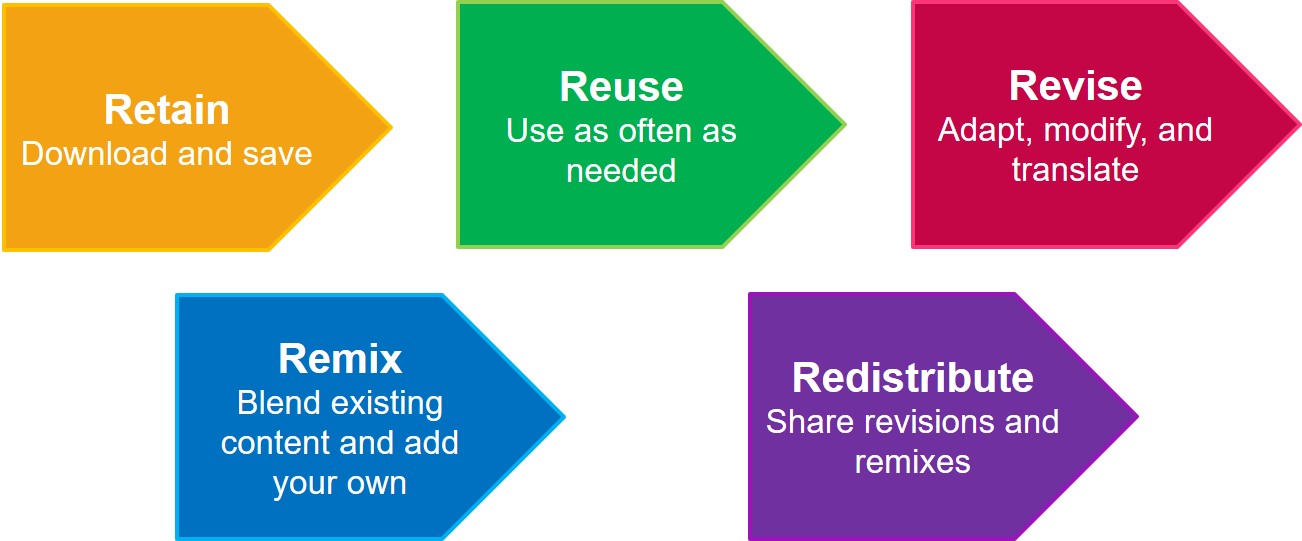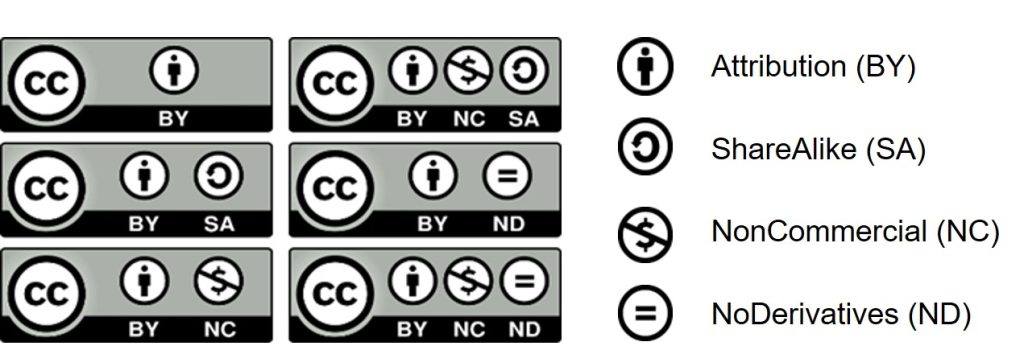The What and Why of OER
Page Sections
What are Open Educational Resources (OER)?
OER = Be Free + Be Openly Licensed + Fulfill the 5R’s of Open
Open Educational Resources (OER) are…
Learning, teaching and research materials in any format and medium that reside in the public domain or are under copyright that have been released under an open license, that permit no-cost access, re-use, re-purpose, adaptation and redistribution by others (UNESCO, 2021).
They range from textbooks to entire courses and everything in between, including videos, podcasts, tests, exercises, websites, software, simulations, case studies, presentations slides, and more. The key is that they can be widely distributed and adapted because they are at no cost to the user and are not subject to the usual copyright restrictions because the copyright holder has applied an open licence giving advanced permissions for their resource. This openness is most often indicated by a Creative Commons Licence.
What can be done with OER? The 5R’s of Open

Benefits of Open Educational Resources
- OER are free (or low-cost if printed) and thus affordable for students, making education more accessible.
- They can be customized and adapted to the course context and combined with other content and interactive or multimedia elements to provide richer teaching and learning opportunities.
- They offer remote and continued access since most OER are digital, do not require an access code and do not expire.
- They contribute to students’ success and completion by easing their financial burden without having a negative impact on their learning.[1]
- OER can be an opportunity to co-create knowledge with students in the form of renewable assignments rather than limiting their role to that of consumers of information.
The adaptation of existing open educational resources and the creation of new resources are also opportunities to make course materials more accessible, inclusive, and representative for learners. This kind of flexibility rarely exists in traditional textbooks. Because OER are not created to satisfy a commercial market, they can address topics and include perspectives that would otherwise be neglected.
What are Creative Commons (CC) Licenses?
Creative Commons Licenses act like a permission. When a creator applies one of the six free licenses on their work, they retain their copyright but allow the public to share, remix and reuse the work legally without having to ask permission or pay additional fees, provided that the user complies with the conditions of the licence.
The six CC Licenses consist of three elements: the CC logo, icons representing a combination of conditions (which can also be represented by two letters or written out in long form), and the version (4.0 International is the most recent).

The most open of these licenses is CC BY, requiring attribution only. The most restrictive (but still more open than copyright’s “all rights reserved” approach) is CC BY-NC-ND (Creative Commons Attribution-Non-Commercial-NoDerivatives License), which requires attribution but does not allow for commercial use and adaptations.
Note about NoDerivatives and Open Access:
Resources with the ND (NoDerivatives) condition are not Open Educational Resources. ND indicates that the user cannot make changes to the original version to incorporate it into a new resource. This condition goes against two of the 5R’s of Open: revising and remixing. Instead these resources are Open Access resources, where they are free and open but do not fulfill all 5R’s of Open. For disciplines with few OER, some non-modifiable resources are suggested in this guide. If no modifications are made, they can be assigned to course material lists without having to request additional permissions.
Learn more about CC licenses on the Creative Commons website.
Other Open Licenses
In some disciplines and resource types may have other open licenses applied either instead of a Creative Commons License or as well as.
For disciplines such as computer science, engineering, and mathematics, the following software licenses are sometimes applied to OER:
Local Contexts have developed Labels, Notices, and Licenses to support and recognize the knowledge and data of Indigenous communities. These include:
- Traditional Knowledge (TK) and Biocultural (BC) Labels
- Traditional Knowledge (TK), Biocultural (BC), and Institutional Notices
- Traditional Knowledge (TK) Licenses
- V. Clinton & S. Khan, (2019), “Efficacy of Open Textbook Adoption on Learning Performance and Course Withdrawal Rates: A Meta-Analysis,” AERA Open, CC BY-NC 4.0. R.S. Jhangiani et al., (2018), “As Good or Better than Commercial Textbooks: Students’ Perceptions and Outcomes from Using Open Digital and Open Print Textbooks,” The Canadian Journal for the Scholarship of Teaching and Learning 9(1). C. Hendricks et al., (2017), “The Adoption of an Open Textbook in a Large Physics Course: An Analysis of Cost, Outcomes, Use, and Perceptions,” The International Review of Research in Open and Distributed Learning 18(4), CC BY 4.0. H.M. Ross et al., (2018), “Open Textbooks in an Introductory Sociology Course in Canada: Student Views and Completion Rates,” Open Praxis 10(4), CC BY 4.0. ↵

